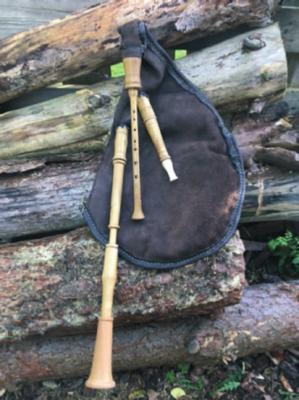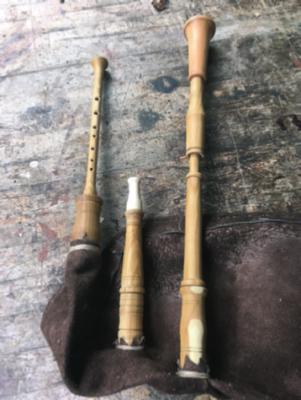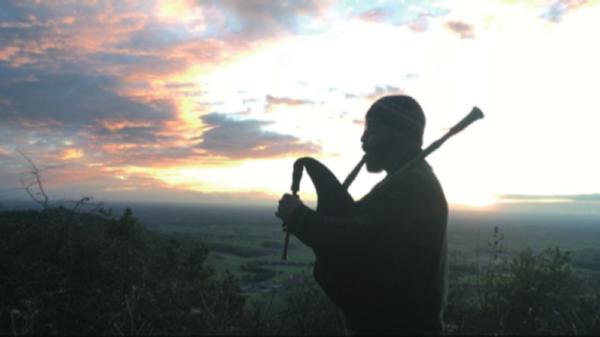The Bagpipe Society
Making a Medieval Smallpipe

I’ve been playing medieval tunes on various bagpipes for a while now, mostly pipes that have a reasonably strident strong tone and volume. These include an English Border style mouth blown single drone G set, a medieval style border set in A, a high D Jim Parr medieval bagpipe and also a mouthblown Slovak gajdy in F. All of these bagpipes have plenty of presence, which is usually what I require when out and about playing, quite often accompanied by drums and percussion.
However there are times when its useful to be able to play with less volume, indeed sometimes indoors in a quiet environment these pipes can be a tad on the loud side……..
Usually when I’ve needed to play for an occasion where the pipes are too overbearing, picking up a recorder or fiddle has worked very well, but maybe it would be good to also have a gentler voiced bagpipe to hand?
Readers of Chanter with be very familiar with types bagpipes that have just that sort of sound, the Northumbrian smallpipes, Scottish smallpipes, Musette fitted with double reeds, and the many softer spoken single reeded bagpipes such as the Sackpipa. What I decided to do was try to make a mouth blown double reeded smallpipe with one drone that had the appearance of bagpipes of the 13th‑15th centuries.
Idea
It might be useful to define what I mean by a “smallpipe”. A smallpipe to me is a bagpipe that is made with a cylindrical bore in the chanter, a tube basically, as opposed to chanters with conical bores. I have a Scottish smallpipe chanter in D that was played in a primary school group I taught a few years ago.

Scottish smallpipes are a relatively recent bagpipe, developed by Colin Ross and others from the Northumbrian pipes in the 1970s and 80s. It’s an open-ended chanter that uses a Northumbrian reed and works well with half closed fingering and has become very popular among Highland pipers as an alternative, quieter instrument. This is more or less what I wanted for my medieval smallpipe, so attempting to copy this chanter would be a good place to start.
Construction
I’ve had a little experience making Northumbrian reeds but decided to make a synthetic reed as opposed to cane, as this bagpipe would be mouthblown and a standard Northumbrian reed would soon stop playing when exposed to moisture in the breath. A reed was made using a plastic pot (Itsu Noodles!) and the staple from brass tubing. I highly recommend the Colin Ross reedmaking book available from the Northumbrian Pipers Society for anyone interested in making these types of reeds.
The reed played nicely in the D chanter, so now I needed to make a chanter that agreed with the reed!
I had some suitable pieces of Laburnum that I roughly turned into blanks, picked one for the chanter and now needed to drill a 4mm bore up the centre.
Northumbrian pipemaker, Kim Bull, kindly gave me advice and a drawing of how to make a D bit drill from a length of tool steel. Slowly feeding the drill into the wood and removing regularly to clean the swarf left a bore of the required length after 20minutes or so. It had wandered no more than 1\4" which allowed for the exterior of the chanter to be turned once the bore was located between centres on the lathe. My lathe is a Jet 1015 mini woodturning lathe, only just long enough to turn the chanter. The drone would need to be made in sections to allow for the final overall length. At this stage I intended the pipes to play in D.

The bag was made with the usual saddle stitched seam method and proved fairly airtight right away. I still dressed it with bagpipe seasoning which I like to do with all my mouth blown pipes.
Tuning and playing
After the tone holes were marked out the drilling and tuning and reed adjustment took place, half way through I decided that it would be a good idea to have the pipes play in E minor, a mode which would allow for the playing of many of the medieval tunes in my repertoire and would also mirror how I play the Jim Parr high D set. That set of pipes originally had a single D drone, but I drilled a second hole in the bell to allow it to tune to E (it can then be plugged if needed back in D).
As it turned out the lower notes had quite large diameter tone holes, and very small holes to play the notes at the higher end of the scale. Some I needed to tune with wax further reducing the size of the tonehole, but surprisingly allowed for a cross fingered semi tone on the C# and Cnat. I can only attribute this to the small size of the toneholes and a feature not present on the original Scottish smallpipe chanter.
Also the fingering was entirely open as in whistle fingering, the effect of half closing the chanter still works as an ornament without knocking the notes out of tune.
The drone was turned also on a 6mm diameter bore, and is made up of three pieces, bottom section with a single reed inserted where it fits the stock, a top section forming the tuning slide and a separate bell turned from a piece of plumwood seated with a push fit at the end of the drone.
I set this up to play an E only but will probably make the next one as a D\E combination. The drone has a strong presence and some interesting harmonics and initially I considered that it was a little too loud for the chanter, but this is in part due to the position of the drone close to the ear. Either way I’m quite happy with the way it sounds now.
Conclusion
All in all, the end result was very pleasing and has given me a bagpipe that is enjoyable to play and listen to, as well as being a useful addition to a range a sounds I can offer when playing out.
Its also useful in that it’s a quiet “practice set” that can be played in the house.
I’ve learned a lot making these pipes, lessons that can be applied to sets of pipes I hope to make in the near future.
I have posted a video of them being played on YouTube which can be viewed on my Dunholmpiper channel https://bit.ly/Chanter141
- Data Processing Notice (GDPR)
-
@BagpipeSociety on X (formally known as Twitter)
-
TheBagpipeSociety on Instagram
-
 BagpipeSociety on Facebook
BagpipeSociety on Facebook
Something wrong or missing from this page? Let us know!
